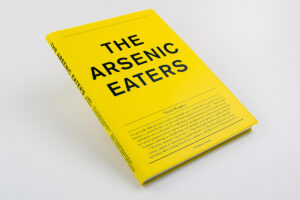YOUR CART
- No products in the cart.
Subtotal:
€ 0

Concept, photography and texts:
Simon Brugner
Text editing and proofreading:
Scott Clifford Evans
Edit:
Simon Brugner
Rob van Hoesel
Design:
Rob van Hoesel
Lithography:
Sebastiaan Hanekroot (Colour&Books)
Production:
Jos Morree (Fine Books)
Print:
Wilco Art Books (NL)
Binding:
Patist (NL)
Supported by:
Das Land Steiermark
Wien Kultur
rhtb: projekt
Retter Reisen
In The Arsenic Eaters, Simon Brugner investigates the widespread historical belief that the consumption of arsenic, one of the most potent mineral poisons, is beneficial to one’s health. Many ‘poison eaters’ were found among the pre-20th century rural population in the eastern parts of the Alps (especially in Styria, Austria). Still accessible arsenic mines in that region date back as far as the 14th century.
Arsenic eaters were robust people, usually from the lower classes of society. They ingested arsenic to be strong and healthy, to look rosy and to boost their sexual potency. Living off the mountains subjected them to physical hardship. Eating arsenic made them more resilient.
“See how strong and fresh I am, and what an advantage I have over you all! In times of epidemic fever or cholera, what a fright you are in, while I feel sure of never getting an infection.”
— Heisch, C., “The Arsenic Eaters of Styria”, Boston Medical Journal, 1860.
Although it was a popular custom among hard-working people, arsenic eaters were anxious to conceal their use. Eating arsenic was taboo. It was believed that once a person became an arsenic eater, he could never stop the habit.
The book consists of two parts. The first part, a visual study, traces the myth of the poison eaters and tries to find a link between that past and our present existence. It sketches a possible reality in which the surreal story of the arsenic eaters makes sense. The second part presents Brugner’s cultural-historical research findings connected to the topic: on historic mining, superstition, medicine and pre-20th century Alpine life in general. The book features contemporary photographs as well as archival material.
Simon Brugner lives and works in Vienna. Brugner is interested in research-based photography projects with a strong historical background, utilizing archival material as well as contemporary photography. He is specifically interested in the question of how the forgotten past forms our present. He obtained a master’s degree in media theory from the Technical University of Vienna (thesis: “On reality in the age of digital photography”). In 2014 Brugner was accepted for the Anzenberger Masterclass (Vienna; with e.g. Martin Parr, Rob Hornstra, Cristina de Middel) and since then selected to take part in several workshops (with Corinne Noordenbos, Lara Almárcegui, RVB Books). In 2016 he was rewarded with a scholarship for promising young artists by the Austrian Federal Ministry for Arts and Culture.